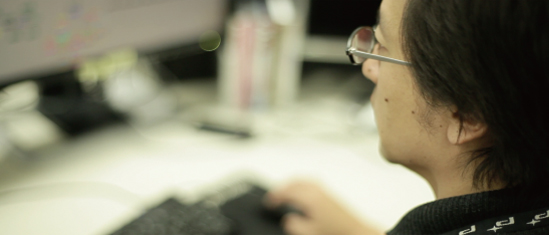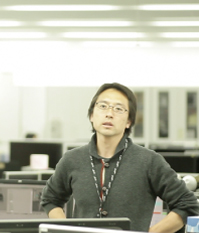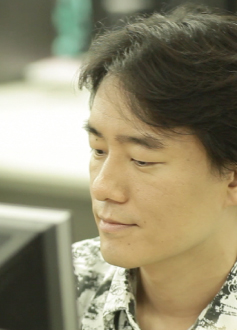(Continues from Part One.)
Creation through trial and error
Inoue: One of the games we worked on during our days at Capcom, Devil May Cry, began as a sequel to Resident Evil. The original design document I got included all kinds of acrobatic action. It was totally different from what people associate with the RE series. We figured that if that’s the style of game we were going for, it would make sense for the player character to be more active. We continued to adjust the animations to fit this style, and eventually the game had morphed into something else entirely.

Yamaguchi: We stayed true to the director’s vision, and that’s how it turned out. In the end, the game was fun the way it was, and the company decided to release it as a new series. Quite a rare case in the game industry.
Inoue: That’s true. That may have been an exceptional case, but I find that when all the team members consider the direction they’ve been given and arrange all the parts of a game to the best of their ability, they end up creating something better than just going by the numbers. Of course, if you are told your idea just won’t work, you have to accept that too. In recent years motion capture technology has become predominant, increasing productivity and allowing us to experiment with all different types of animations.
Yamaguchi: I see what you mean. Technology like that gives a huge boost to efficiency, and it also lets us devote our resources to other areas. For example, even for a single animation, we start by creating a temporary animation and implementing it into the game at an early stage. That way, the team can take a look at it and discuss what works best in the game. Of course animation quality is important for its own sake, but at a company like ours, where we focus on how things move and feel within the actual game, this kind of testing is essential.

Inoue: If the animation you spend a week working on ends up getting thrown out, the programmer has nothing to work with and can’t do his job. Even if it means just making a quick asset swap, a temp animation is better for the sake of efficiency. At the same time, when it comes to animations, the more the better. The player will be happier seeing a hundred animations than just ten, no matter how beautiful those ten are. Even if your action system is great, if that’s all you have the player will soon get bored.
Yamaguchi: When it comes to action games the questions you have to ask are “How does it feel to play?”, “How much variation is there?” Since this is something players will spent hours playing, it may seem obvious, but I think this attention to detail is something essential for anyone who hopes to make games.
Inoue: I start by asking “Do I enjoy this?” From there I ask the people around me, and eventually I’m convinced that “players are going to like this too.” Though frequently I end up making things that I enjoy personally, but I doubt would be much fun to anyone else! Before games are released there are user tests and all that, but at the end of the day these are just a subset of the players who will end up trying the game, so you can never say for certain if the results of testing are representative.
Yamaguchi: When creating a new game, some people aim to make it the new standard for that genre. For us, however, it’s more about just making a quality action game, one we can enjoy ourselves. Of course if it’s recognized as a quality title, that makes me happy as well.
Inoue: That way of thinking is thanks to the development environment we have here at PlatinumGames. As opposed to a vertical line of command with orders coming down from on high, it’s a flat organization centered around the director. You get instant feedback on everything you make, which helps get you closer to making something fun. The physical distance between people is important for this kind of process. If your group is too spread out, it becomes hard to achieve meaningful communication.
Yamaguchi: It would be nice if you could just have everyone sitting beside you at all times, though sadly that’s physically impossible.
Inoue: When you have to discuss something with someone from a different section, that distance becomes apparent. In order to overcome this, instead of using my phone or email, I get up and go over to the seat of the person I need to talk to, you know, make use of some of that non-verbal communication. Also, if I ever hear someone say my name I always respond, no matter how far away they’re standing. When someone says your name it means they’re talking about something you’re involved with, so I make sure I get involved in that conversation.

Yamaguchi: There are no partitions between sections in PlatinumGames, so mini-meetings often pop up all over the place. A lot of progress is made while standing and chatting, or while watching someone play a demo at their desk. These talks start all of a sudden, so sometimes we realize too late that there is someone missing who really needs to be there.
Inoue: I’m aware that at other companies they have schedules that are absolute, and design documents laying out every stage of production; what we use are more like flexible indicators. This makes sense considering how much the original design seems to be missing by the time our games approach completion. If you are able to follow your original plan and reach the bar you set for yourself that’s fine from a work perspective, but unless you go through those heated discussions with other people on the team, I don’t think you’ll ever realize a game’s true potential.
Yamaguchi: After all, players couldn’t care less about your design documents. Without them it’s hard to make a strategy guide though, so the person in charge of that might get upset if I say that! Personally, though, I’d rather make something fun than something faithful to a document any day.
(Continues to Part Three)
interview by editorial studio MUESUM (2012/06/29)